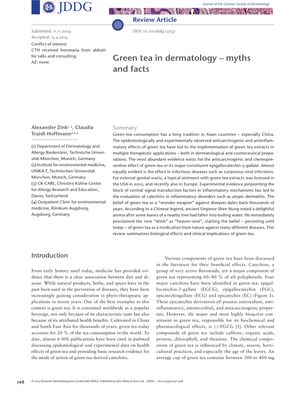TLDR Green tea may help with skin health and protect against UV damage, but more research is needed to confirm its safety and effectiveness.
The document from 2015 reviews the dermatological benefits of green tea and its major constituent, epigallocatechin-3-gallate (EGCG). It highlights green tea's anticarcinogenic, anti-inflammatory, antimicrobial, and chemopreventive properties, and its use in treating cutaneous viral infections, such as external genital warts. Green tea extracts have been shown to offer UV protection, potentially reduce skin cancer risk, and have beneficial effects on several dermatological diseases. The polyphenols in green tea may also contribute to sunscreen protection, anti-aging cosmetic products, and have shown efficacy against HPV-induced skin conditions and possibly HIV replication. Green tea could be beneficial for inflammatory skin diseases and hair disorders like androgenetic alopecia. However, the document emphasizes the need for more rigorous studies to confirm the efficacy and safety of green tea in dermatology.
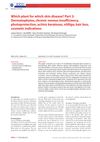 19 citations
,
August 2010 in “Journal der Deutschen Dermatologischen Gesellschaft”
19 citations
,
August 2010 in “Journal der Deutschen Dermatologischen Gesellschaft” Certain plant extracts can effectively treat skin conditions like athlete's foot, chronic vein problems, sun damage, skin growths, vitiligo, and hair loss, and may also improve skin appearance.
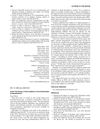 3 citations
,
June 2009 in “The journal of alternative and complementary medicine/Journal of alternative and complementary medicine”
3 citations
,
June 2009 in “The journal of alternative and complementary medicine/Journal of alternative and complementary medicine” Green tea extract may help reduce excessive hair growth.
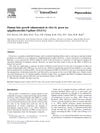 108 citations
,
November 2006 in “Phytomedicine”
108 citations
,
November 2006 in “Phytomedicine” Green tea component EGCG could potentially promote human hair growth.
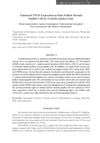 3 citations
,
January 2018 in “Chiang Mai University Journal”
3 citations
,
January 2018 in “Chiang Mai University Journal” Centella asiatica extract may help promote hair growth.
 13 citations
,
December 2017 in “BMC Complementary and Alternative Medicine”
13 citations
,
December 2017 in “BMC Complementary and Alternative Medicine” The Asian herbal mix with Houttuynia cordata, Perilla frutescens, and green tea helped grow hair in mice.
 1 citations
,
February 2017 in “Journal of pharmacology & clinical research”
1 citations
,
February 2017 in “Journal of pharmacology & clinical research” The herbal hair gel with Eclipta alba and Lippia nodiflora extracts was more effective at growing hair than the control gel and minoxidil.
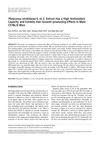 12 citations
,
September 2014 in “Journal of Food Science and Nutrition”
12 citations
,
September 2014 in “Journal of Food Science and Nutrition” Platycarya strobilacea extract is a strong antioxidant that can grow hair better than minoxidil.
 3 citations
,
January 2022 in “Precision medicine and clinical omics”
3 citations
,
January 2022 in “Precision medicine and clinical omics” Beta-sitosterol and stigmasterol might help prevent hair loss by blocking a specific enzyme.
